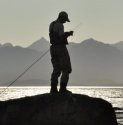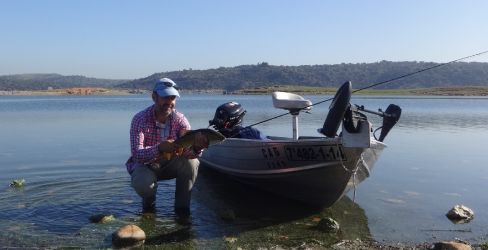Jim Levison has been photographing the outdoors for the past twenty years. For the last eleven years Jim has been guiding saltwater fly anglers off the fabled waters of Montauk Point, New York, in search of striped bass, blue fish and false albacore. Jim spends about one hundred days a year on his home waters in the Northeast constantly photographing new images for his stock portfolio. He has worked with Orvis, Gray's Sporting Journal, Cortland, St. Croix Rod Co., Field and Stream Magazine, Outdoor Life Magazine, Saltwater Fly Fishing, Fly Fishing In Saltwaters Magazine, Fly Fisherman Magazine, Urban Angler Fly Shop and Southwestern and Eastern Fly Fishing Magazines and more. It is our pleasure to share Jim's work with you.
Fd: When did you start fly-fishing? Can you tell us about your memories from those times?
JL: I started fly fishing when I was 34 years old so I have been fly fishing for a little over 30 years. I started fly fishing in New York’s Catskill Mts., the birthplace of American fly fishing back in the late 1800’s. It still is one of the east coast of Americas best trout areas. I always love going back up there for the Hendrickson hatch.
Fd: Photography is one of your passions, along with fly-fishing. How do you handle both at the same time when you are outdoors?
JL: I am a saltwater fly fishing guide in Montauk, New York (www.allmontaukflyfishing.com)I got into the habit many years ago of always taking the camera with me on charters. I have learned when I can and cannot shoot with clients aboard. If it’s a world class shot I have to shoot, just can’t help myself but usually the client comes first. Also one of the rules of fishing and photography is that either photograph or fish, don’t try to do both at the same time, your results for both will suffer. Lay the rod or the camera down.
Fd: Do you have any mentors in regard to fly-fishing photography?
JL: No, I am pretty much self-taught. Although I look at other fly fishing photographers work to give me inspiration and ideas for different ways to shoot. People who know who the popular fly fishing photographers are can pretty much tell who took the shot before they read the by line. We all have individual styles of how we shoot.
Fd: When you go out on a photography and fly-fishing session, do you have certain ideas of the pictures and the work you will do, or you prefer to see where the moment takes you?
JL: Actually both. If I have something in particular I want to shoot or have been hired to shoot a certain project I will hit the water with certain pre conceived shots or themes in mind. But nature is tricky and you have to be prepared for whatever it throws at you. If not, you can possibly lose some great shots.
Fd: What kind of photo setup do you use or want to try next?
JL: Actually I am in the process of figuring out what I need for underwater photography. I have lost some opportunities for both great shots and shots to complete a story because I am not set up for underwater. My biggest regret is not being yet set up.
Fd: What would you recommend to the starting photographer and to the anglers that want to have better pictures of their fishing trips and catches?
JL: Look at magazines whose fishing photos you admire and try to copy them to the best of your ability. Always bring your camera with you and either fish or photograph, don’t try to do both at the same time. If taking a hero shot of your fishing buddy holding a fish be prepared before the fish is landed. You want to minimize time out of the water for the fish.
Fd: You have been travelling all over the world for years because of fishing.
A) Which are your favorite fresh and saltwater spots?
The Bahamas for saltwater, primarily bonefish. For freshwater you cannot top the American west, especially Montana.
B) Could you tell us some of your best memories from your trips? Any funny story or risky situation that you recall?
Fantastic food and accommodations at the Rio Manso Lodge in Patagonia. The airport in Murmansk, Russia is right out of a science fiction movie and not in a good sense. Havana, Cuba is a very unique city in today’s world. It’s like time has stood still for the last fifty years.
C) Any special memories of the people you fished and worked with in your trips?
I have developed a few very good fishing clients from meeting them on trips. Big Charlie who operates a lodge in Andros, Bahamas is great guide and lots of fun. As a matter of fact I think the Bahamas has some of the best fly fishing guides on the planet.
Fd: Do you have spots and species in your bucket list?
JL: Los Roques in Venezuela, the Seychelles, Christmas Island and permit trip to Belize. I would love to catch small Bluefin tuna on the fly, go on a Giant Trevally trip and catch some good size tarpon (they do not have to be giants).
Fd: What is it that you enjoy the most about your job?
JL: Fly fishing both fresh and saltwater has taken me to incredible places I probably would not have gone to if I did not fly fish. The fly fishing crowd for the most part is a terrific group of people to be around.
Fd: As a final point, what does fly-fishing mean for you?
JL: I spent 23 years in the New York City Police Dept. Fly fishing has given me the opportunity to pursue both photography and fishing and make some money at it. Remember the saying “do what you love, the money will follow”. I have not gotten rich but it has been a great ride.




























